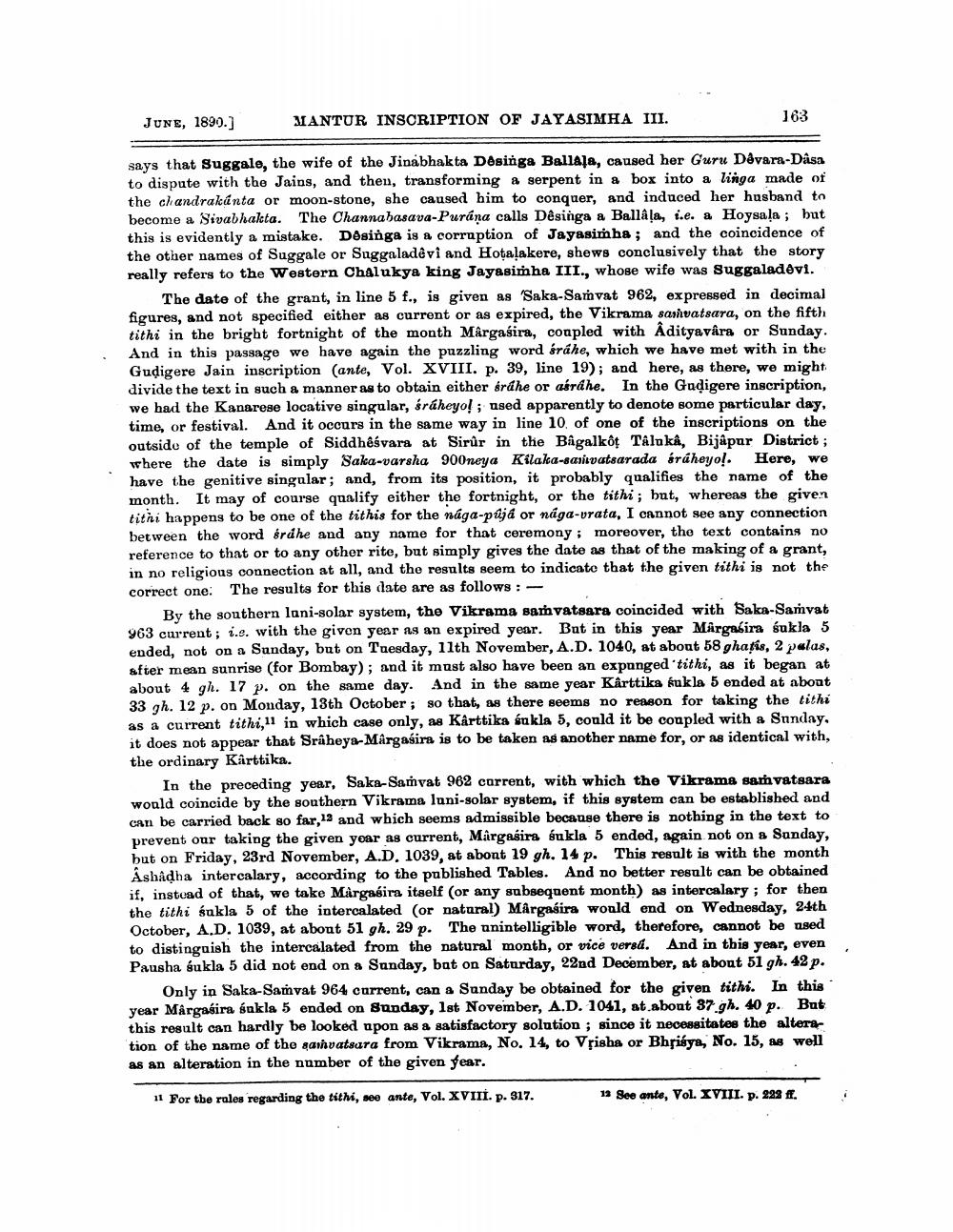________________
JUNE, 1899.)
MANTUR INSCRIPTION OF JAYASIMHA III.
163
says that Suggale, the wife of the Jinabhakta Desinga BallAla, caused her Guru Dåvara-Dasa to dispute with the Jains, and then, transforming a serpent in a box into a linga made of the chandrakanta or moon-stone, she caused him to conquer, and induced her husband to become a Sivabhakta. The Channabasava-Purána calls Dêsinga a Ballâla, i.e. a Hoysala ; but this is evidently a mistake. Desinga is a corruption of Jayasimha ; and the coincidence of the other names of Suggale or Suggaladevi and Hotalakere, shews conclusively that the story really refers to the Western Chalukya king Jayasimha III., whose wife was Suggaladevi.
The date of the grant, in line 5 f., is given as 'Saka-Samvat 962, expressed in decimal figures, and not specified either as current or as expired, the Vikrama sasivatsara, on the fifth tithi in the bright fortnight of the month Margasira, coupled with Adityavâra or Sunday. And in this passage we have again the puzzling word éráhe, which we have met with in the Gudigere Jain inscription (ante, Vol. XVIII. p. 39, line 19); and here, as there, we might divide the text in such a manner as to obtain either dráhe or asráhe. In the Gudigere inscription, we had the Kanarese locative singular, śráheyo!; ased apparently to denote some particular day, time, or festival. And it occurs in the same way in line 10, of one of the inscriptions on the outside of the temple of Siddhêśvara at Sirûr in the Bagalkot Taluka, Bijapur District; where the date is simply Saka-varsha 900neya Kilaka-sarivatsarada éráheyo!. Here, we have the genitive singular; and, from its position, it probably qualifies the name of the month. It may of course qualify either the fortnight, or the tithi ; but, whereas the given titni happens to be one of the tithis for the nága-pujá or naga-vrata, I cannot see any connection between the word śráhe and any name for that ceremony; moreover, the text contains no reference to that or to any other rite, but simply gives the date as that of the making of a grant, in no religious connection at all, and the results seem to indicate that the given tithi is not the correct one: The results for this date are as follows:
By the southern lani-solar system, the Vikrama samvatsara coincided with Saka-Samvat 963 current; i.e. with the given year as an expired year. But in this year Margasira sukla 5 ended, not on a Sunday, but on Tuesday, 11th November, A.D. 1040, at about 58 ghatis, 2 palas, after mean sunrise (for Bombay); and it must also have been an expanged 'tithi, as it began at about 4 gh. 17 p. on the same day. And in the same year Karttika sukla 5 ended at aboat 33 gh. 12 p. on Monday, 13th October; so that, as there seems no reason for taking the tithi as a current tithi, 11 in which case only, as Karttika sukla 5, could it be coupled with a Sunday, it does not appear that Srâheya-Margasira is to be taken as another name for, or as identical with, the ordinary Karttika.
In the preceding year, Saka-Samvat 962 corrent, with which the Vikrama samvatsara would coincide by the southern Vikrama luni-solar system, if this system can be established and can be carried back so far, 12 and which seems admissible because there is nothing in the text to prevent our taking the given year as current, Märgasira sukla 5 ended, again not on a Sunday, but on Friday, 23rd November, A.D. 1039, at about 19 gh. 14 p. This result is with the month Åshadha intercalary, according to the published Tables. And no better result can be obtained if, instead of that, we take Margasira itself (or any subsequent month) as intercalary; for then the tithi sukla 5 of the intercalated (or natural) Mårgasira would end on Wednesday, 24th October, A.D. 1039, at about 51 gh. 29 p. The unintelligible word, therefore, cannot be used to distinguish the intercalated from the natural month, or vice versa. And in this year, even Pausha sukla 5 did not end on a Sunday, bat on Saturday, 22nd December, at about 51 gh. 42 p.
Only in Saka-Samvat 964 current, can a Sunday be obtained for the given tithi. In this year Mârgasira sukla 5 ended on Sunday, 1st November, A.D. 1041, at about 37 gh. 40 p. But this result can hardly be looked upon as a satisfactory solution ; since it necessitates the altera tion of the name of the samvatsara from Vikrama, No. 14, to Vpisha or Bhrisya, No. 15, as well as an alteration in the number of the given year.
11 For the rules regarding the tithi, see ante, Vol. XVIII. p. 317.
13 See ante, Vol. XVIII. p. 223 ff.




